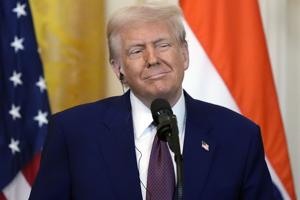Appellate court judges have expressed profound skepticism regarding former President Donald Trump’s authority to levy extensive tariffs without explicit congressional approval, setting the stage for a significant legal challenge. An 11-judge panel of the U.S. Court of Appeals for the Federal Circuit meticulously questioned the administration’s legal rationale, highlighting a critical debate over presidential economic powers.
The core of the judicial inquiry centered on the Trump administration’s reliance on the International Emergency Economic Powers Act (IEEPA) to justify its broadest batch of tariffs. Judges repeatedly conveyed their incredulity, noting that the 1977 law, originally enacted to address national emergencies, does not explicitly mention “tariffs” anywhere within its text, raising questions about its applicability to such trade measures.
During sharp exchanges, the appellate judges pressed the government attorney on whether IEEPA indeed extended to imposing tariffs and, if so, whether the specific levies genuinely corresponded to the national threat identified by the administration. Chief Circuit Judge Kimberly Moore illustrated this concern with a hypothetical: “If the president says there’s a problem with our military readiness,” she posited, “and he puts a 20% tax on coffee, that doesn’t seem to necessarily deal with (it).”
Despite the judicial skepticism, the Trump administration maintained that Congress’s passage of IEEPA granted the president “broad and flexible” power to respond to emergencies, while simultaneously asserting that the president was “not asking for unbounded authority.” No ruling was issued from the bench, but legal experts widely anticipate that this landmark legal challenge will ultimately reach the U.S. Supreme Court, underscoring its profound implications for future trade policy.
Former President Trump himself weighed in on the ongoing case, taking to his Truth Social platform to underscore his conviction that tariffs are essential for national protection and survival. This public defense follows an earlier instance where a three-judge panel of the U.S. Court of International Trade in New York had also expressed similar doubts regarding the administration’s justification for these particular tariffs, paving the way for the current appellate review.
It is crucial to note that this specific legal challenge primarily targets Trump’s so-called “Liberation Day” tariffs, which were imposed on April 2 and introduced new levies on a vast array of goods from nearly every country. However, the case does not encompass other significant Trump tariffs, such as those previously imposed on steel, aluminum, and certain Chinese imports, some of which President Joe Biden has subsequently chosen to continue.
This case is one of at least seven lawsuits accusing former President Trump of overstepping his authority through the use of tariffs against other nations. The U.S. Constitution traditionally grants Congress the sole authority to impose taxes, including tariffs, but over several decades, lawmakers have progressively ceded power over trade policy to the White House. Trump notably capitalized on this shift, increasing the average U.S. tariff rate to over 18%, the highest since 1934, according to analyses by Yale University.
Among the plaintiffs are 12 U.S. states and five businesses, including a wine importer and companies dealing in pipes, plumbing goods, and fishing gear. Oregon Attorney General Dan Rayfield, representing one of the suing states, expressed strong confidence after the hearing, asserting that the appellate judges “didn’t buy” the Trump administration’s arguments and that the plaintiffs were in a stronger position moving forward in the US legal system.
Rayfield further highlighted the significant economic repercussions of these Trump tariffs, which are borne by U.S. importers and often passed on to consumers through higher costs. He characterized these levies, implemented solely by presidential executive action, as effectively one of the largest tax increases in American history, underscoring the vast scope of presidential authority in shaping national economic policy.






Leave a Reply